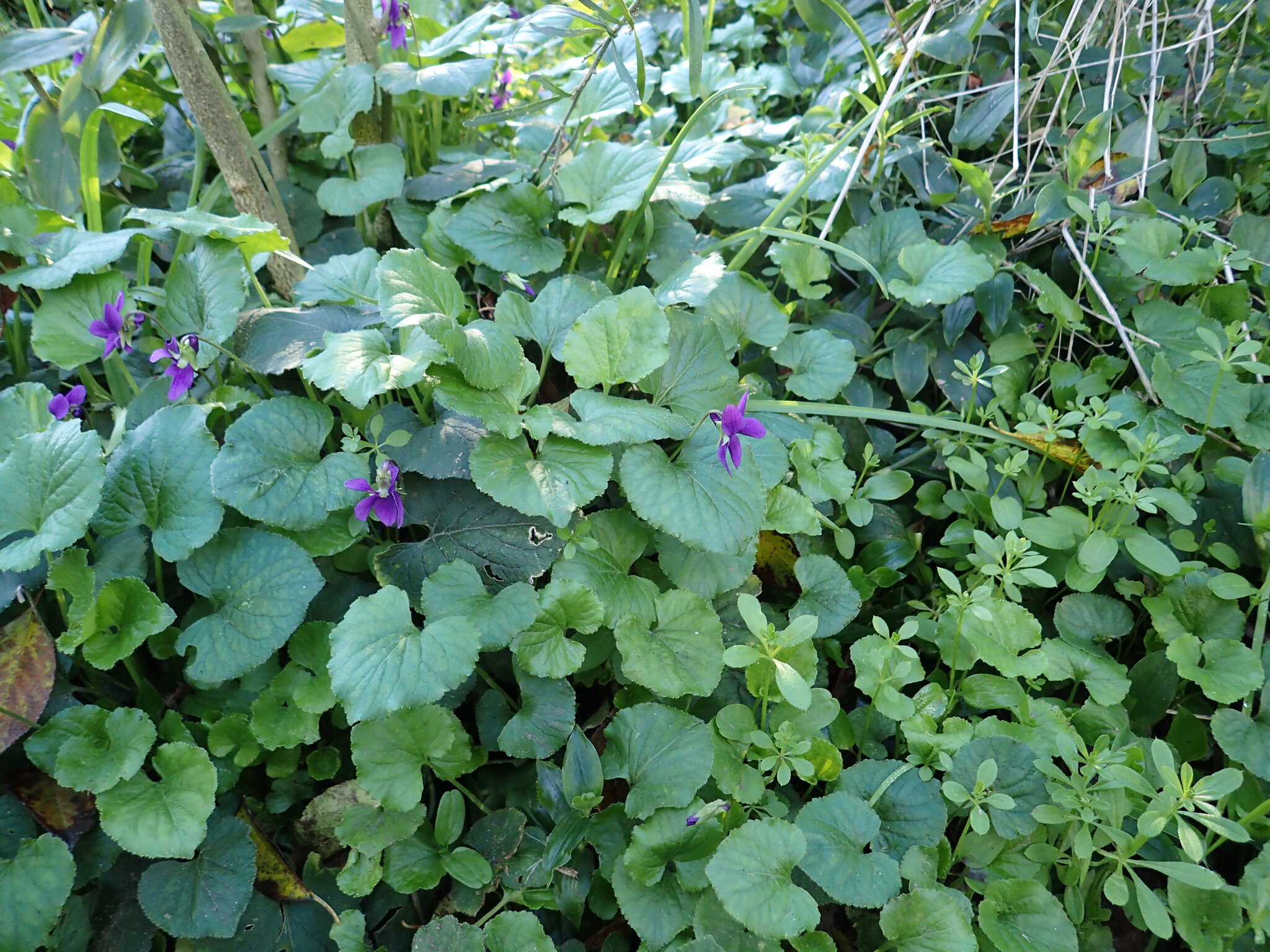
Stoloniferous, tufted perennial. Leaves roundish to ovate and kidney-shaped, round-toothed. Stipules ovate. Flowers fragrant, violet with a range of cultivars in white to rose and reddish-purple. Spur short and straight; winter to spring.
Eurasia, Africa
A wide range of colour and scent cultivars has been raised in England and America.
The cultivars listed under the Cultivar tab are available in Australia:
An essenial oil extract is used in flavouring, perfumery and food decoration.
Coombs (1979).
Source: (1997). Violaceae. In: . Horticultural Flora of South-eastern Australia. Volume 2. Flowering plants. Dicotyledons. Part 1. The identification of garden and cultivated plants. University of New South Wales Press.

Viola odorata 'Admiral Avellan'
Flowers prolific, bright reddish-purple to red, strongly fragrant.
Introduced France 1893.
A white selection of the natural species that has been in gardens for at least 1000 years. ['White Violet']
Flowers prolific, small, rose-pink.
Bred by Honeysuckle Cottage Nursery, New South Wales in 1991.
Flowers rich burgundy with a fine fragrance.
An Australian violet of unknown origin.
Viola odorata 'Coeur D'Alsace'
Low-growing, compact.
A hybrid of 'Rubra' which has medium-sized, sweetly-scented, salmon flowers.
Introduced by Millet in 1916.
Low growing, to 8 cm or so tall. Flowers medium-size, prolific, reddish violet, sweetly scented.
Not to be confused with V. cucullata.
One of the most vigorous of all cultivars.
An old cultivar with semi-double, long-stemmed flowers. Outer row of petals lavender blue, inner petals forming a white rosette with orange splashes. ['Cyclops']
'Mrs David Lloyd George' is considered a synonym by some UK growers but does not correspond to early illustrations.
Introduced France in 1905.
Viola odorata 'Fragrant White'
Free-flowering, compact. Flowers fragrant, white. ['House's White']
Probably the 1888 English cultivar 'Rawson's White' raised by the leading English violet grower the Vicar of Bromley.
This is the (presumably) incorrectly listed name in Australia.
Viola odorata 'Governor Herrick'
Plant without runners. Flowers extremely large, dark purple, lightly scented (in Australia) on long stalks; spring. Partially deciduous in winter. ['General Herrick', 'Lord General Herrick']
The most widely grown violet in the UK resulting from a cross between V. odorata and the North American sister violet V. sororia.
Flowers with good form and scent, distinctly grey coloured slightly tinged with lilac. ['Birch Violet']
Probably of Australian origin.
Viola odorata 'John Raddenbury'
Foliage attractive. Flowers large, single, sky blue, sweetly fragrant on tall stems. ['John Raddburg']
Introduced Australia 1895. John Raddenbury was Curator of the Geelong Botanic Gardens in Victoria from 1872-96.
A violet with great commercial success in the UK and France.
Jones, G. (1984).
Viola odorata 'King Of The Doubles'
Stems long, leaves attractive. Flowers double, intensely fragrant, purple striped with white in the outer petals, the inner petals curved over to form a white-petalled eye with purple stripes.
Forms excellent bunches.
Similar to a plant listed in England as 'Mrs David Lloyd George'.
Plant vigorous. Flowers clear rose pink, very fragrant.
Bred from 'Rosine' by Honeysuckle Cottage Nursery, New South Wales in 1987.
An old cultivar with fragrant pale lavender medium-size profuse flowers.
Often found in older Eastern Australian gardens.
Forming a dense ground cover. Flowers abundant, opalescent clear reddish purple, very sweetly scented.
Bred by Honeysuckle Cottage Nursery, New South Wales and released in 1988.
Vigorous plant. Flowers abundant, medium-size, sweetly-scented, pale blush pink.
Released by Honeysuckle Cottage Nursery, New South Wales, in 1992.
Habit compact. A seedling of 'Rubra' with attractive coral pink flowers.
Introduced France, 1902.
Plant vigorous, robust. Flowers abundant, the upper petals elongated, subtle lilac-grey.
Released by Honeysuckle Cottage Nursery, New South Wales, in 1991.
Viola odorata 'Princess Beatrice'
Blooms large, bright lavender blue, sweetly fragrant, borne well above the foliage.
Originated 1888.
Flowers semi-double, blue-violet, the inner petals partly folded over the centre of the bloom. ['Queen Mary']
Introduced UK 1917.
Viola odorata 'Princess Of Wales'
Leaves large, shiny. Flowers tall-stemmed, violet blue, exceptionally large and fragrant. ['Princesse de Galles']
The most popular bunching violet used in Australia and also popular internationally.
Introduced France, 1889.
Low-growing, vigorous. Flowers magenta fading to pale purple and with a sweet fragrance.
Flowers medium-size and clear mid-pink. ['Rosea', 'Rosina']
A selected form of the pink Sweet Violet V. odorata var. rosea which has been used as a cut flower in the UK and USA.
Introduced France, 1920.
Vigorous. Flowers rosy red.
Introduced France, 1881.
Flowers deep purple with long stems. ['Purple Czar']
The first violet to be awarded the Royal Horticultural Society prize in 1865 and a popular bunching violet in the UK by the 1880s, also used for hybridisation.
Introduced UK 1863.
Vigorous plant. Flowers prolific with smallish dark purple extremely fragrant blooms.
Bred by Honeysuckle Cottage Nursery, New South Wales,1988.
There are at least 2 variants grown under this name.
The major cultivar in England is a scentless cultivar with creamy yellow flowers having deeper apricot centres.
The Australian variant corresponds to that described by W. Ingwersen in England in 1951 and has flowers that are champagne to primrose and sweetly-scented and have shiny leaves. ['Apricot Violet', 'Yellow Sweet Violet', 'Yellow Queen', 'Sulphurea']
Introduced France, 1896.
Resembles 'John Raddenbury' in flower form and habit but the blue flowers have a distinct pale pink sheen creating an effect of pale lavender pink.
Bred by Honeysuckle Cottage Nursery, New South Wales, 1987 from 'John Raddenbury' and 'Rosine'.